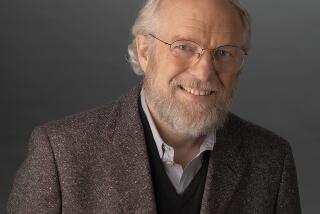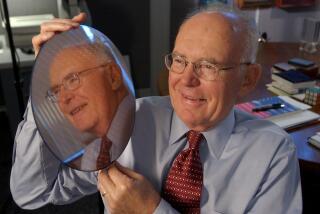‘Father of Television’ Suffered Travails Worthy of a Soap Opera
Television’s reach into modern life stretches from the ridiculous to the sublime to the tragic--”Uncle Miltie” to “Masterpiece Theatre” to the recent terrorist attacks. But none of these memorable TV moments would have occurred without the electronic picture tube invented by the father of television: Philo Taylor Farnsworth.
Fittingly, it was in Los Angeles, the epicenter of entertainment, that Farnsworth saw the man-made light that the rest of the world would soon see too.
In 1921, he was a 14-year-old Utah farm boy when he conceived the idea of what he later called “capturing light in a bottle.” He was tilling a potato field with a horse-drawn harrow when he realized that light, in an electron beam, could scan images just as he was plowing the field: line by line.
Farnsworth, who had been born in a log cabin on the family farm in 1906, somehow saw beyond the arid landscape to a scientific universe. Every day he rode horseback four miles to the nearest school, and as a 12-year-old, persuaded his chemistry teacher, Justin Tolman, to let him take a senior chemistry class and tutor him on the side.
“He devoured electrical encyclopedias like other students wolfed down popcorn,” Tolman said.
Farnsworth was 15 when he drew on Tolman’s chalkboard and on a scrap of paper his design for the first electronic tube. Tolman, who kept the paper for the rest of his life, persuaded Brigham Young University to allow Farnsworth to take an advanced physics course.
Farnsworth’s academic career was cut short when his father died, and he dropped out to help his family, earning money by repairing radios. By 1926, the young genius had come to the attention of a Community Chest fund-raiser, who paid for the 19-year-old inventor and his 18-year-old bride, Elma, his research assistant, to move to Los Angeles.
Apartment Blast Causes Neighbors to Call Cops
Behind closed curtains in his apartment in Los Feliz, Farnsworth began experimenting with glowing tubes. Once, he blew up his equipment, and his neighbors, suspecting that Farnsworth was running an illegal liquor operation during Prohibition, called the cops.
After police raided his apartment and found nothing, Farnsworth and Elma moved to San Francisco--fittingly to a tiny laboratory at the bottom of Telegraph Hill. There, he perfected and patented the first operational all-electronic television transmission tube (a forerunner of the modern TV camera). He was 20 years old.
Months later, in 1927, with the backing of more investors, he devised the first operational television system, with a crude receiver and a camera. The world’s first TV show was a vertical black line swinging back and forth like a pendulum against a lighted background.
An excited investor quickly cabled another investor: “The damned thing works.”
To bring in more investors and attract a large company, Farnsworth began to give demonstrations. The technique worked--and then it backfired. Radio Corp. of America wanted in on the ground floor of TV, and its interest triggered a seven-year court battle. Farnsworth won, but it left him ailing and broken.
Farnsworth Rejects $100,000 RCA Offer
Unlike Thomas Edison, Farnsworth never gained the riches or recognition he deserved. Although he won in a court of law, he lost against RCA, one of America’s largest and most powerful corporations, which co-opted some of his ideas.
In his excitement about his creation, Farnsworth showed many of his secrets to all comers. RCA already had a man working on the TV concept. Russian American scientist Vladimir Zworykin, who had separately conceived major components for TV, visited Farnsworth’s lab in 1930. Fearing the competition, RCA chief David Sarnoff offered Farnsworth $100,000 for his services and patents. But Farnsworth rejected the offer, wanting royalties.
“RCA doesn’t pay royalties,” Sarnoff allegedly said. “We collect them.”
In 1932, Farnsworth was working for Philco Radio to help it break into the television business. That same year, his youngest son died from a throat infection and Philco refused him even the time off to bury his son.
With his personal world crashing in, Farnsworth was sued by RCA for patent interference, and a legal battle ensued over who invented television.
Farnsworth kept plugging away, amazing the world in 1934 with demonstrations of images of tennis players and other athletes at play, along with the face of actress Joan Crawford--all transmitted from one room to another. He had also started his own company, Farnsworth Television Inc.
In court, RCA lawyers were contending that Zworykin’s 1923 patent had priority over Farnsworth’s later patents, but they never presented a working television tube. Farnsworth did, thanks to that long-ago drawing his chemistry teacher preserved. It was his greatest triumph and his legal vindication.
But the victory proved costly. RCA continued to muscle him out of the picture, tying up his patents with appeals. However, RCA was forced to pay Farnsworth $1 million over 10 years beginning in 1939.
But during World War II, the government suspended sales of TV sets, and by the war’s end, Farnsworth’s key patents were close to expiration. When they did expire, in 1947, RCA grabbed them and started a propaganda campaign that claimed Zworykin as the “father of television,” backed up with photos of him holding a cathode ray tube.
Zworykin’s own attitude toward television was clear: “I would never let my children come close to this thing.”
Mystery Guest on ‘I’ve Got a Secret’
Driven to ulcers and depression made worse by drinking, Farnsworth withdrew to a house in Maine. He soon had a mental breakdown, spent time in hospitals and submitted to electric shock therapy. As if that weren’t enough, his house burned to the ground in 1947.
By then, television was coming of age, from the broadcasts of the Army’s McCarthy hearings to the 1949 live coverage in Los Angeles of the effort to rescue a little girl who slipped down a well in San Marino.
In 1957, Farnsworth appeared as a mystery guest on “I’ve Got a Secret,” where he was identified as “Dr. X,” an inventor of “a machine.” The first question from a panelist was: “Is this a machine that might be painful when used?” Farnsworth quipped: “Yes. Sometimes it’s most painful.” None of the panelists guessed what his machine was, or his role in developing TV.
Later, like Zworykin, Farnsworth would say that he felt that he had created a monster.
Worn out by the industry he helped to create, he died from a perforated ulcer in 1971, at age 64. Newspaper headlines credited him as the “father of television.”
In the U.S. Capitol, each state gets to place statues of two of its most accomplished citizens. A dozen years ago, a group of persistent Utah elementary school children lobbying the Senate got Farnsworth’s statue raised up alongside that of Utah’s Mormon founder, Brigham Young.
More to Read
The complete guide to home viewing
Get Screen Gab for everything about the TV shows and streaming movies everyone’s talking about.
You may occasionally receive promotional content from the Los Angeles Times.






